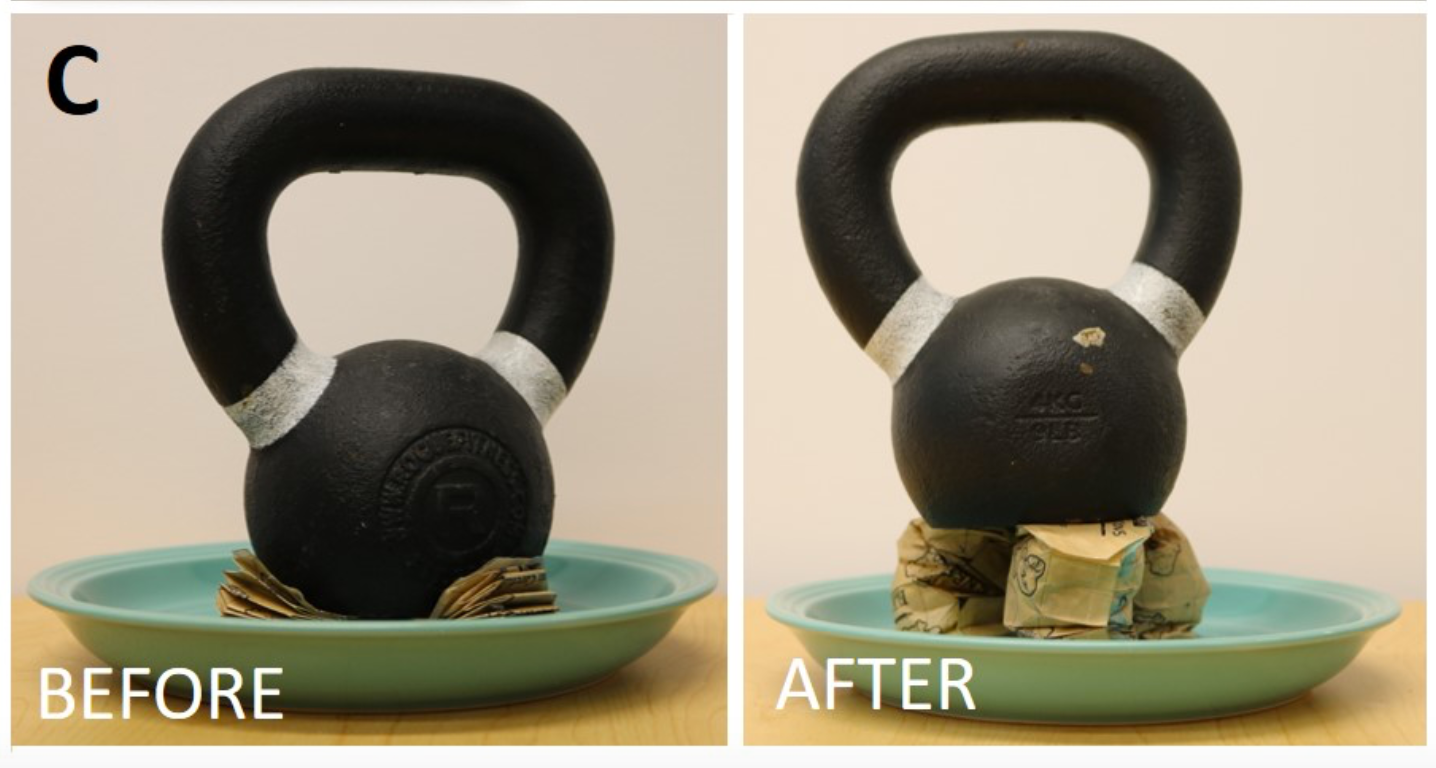How to Make a Robot Move, Using Popcorn
The future is now and it’s happening, appropriately, at Cornell University.

Popcorn is a powerful thing. It can take a microwaveable bag from flat to bulbous in just minutes. It’s loud enough to scare a dog. And if you’ve ever put too many scoops into a stovetop popcorn pot, you may have seen a bunch of kernels work together to push the lid off and escape all over your kitchen.
We saw, we heard, we smelled—and yet we did not fully understand. In a recently published paper, “Popcorn-Driven Robot Actuators,” researchers from Cornell University’s Collective Embodied Intelligence Lab demonstrate how popcorn’s propulsive properties can be used for more than snack-time joy.
Under their tutelage, the humble grain has helped robots change shape, grip objects, and even shoulder moderately heavy weights. “Popcorn seemed like a silly idea at first,” writes lab head Kirstin Hagelskjær Petersen in an email. “But now we believe [it has] real promise for quite a few applications.”
Many of the creations of the Collective Embodied Intelligence Lab are inspired by insects, which, although they’re small, can accomplish a lot by working together in swarms. In the past, Petersen and her lab have developed technology based on termites, spiders, and honeybees.
Popcorn, too, is small but mighty. It is “a multifunctional material that can change its mechanical properties very rapidly,” explains Steven Ceron, a doctoral student in Petersen’s lab, and the paper’s lead author. This makes it a great candidate to power robotic actuators—the parts of robots that, rather than sensing and responding to their surroundings, complete tasks through physical movement. (“To be a [full] robot, it would probably need other parts that were not popcorn-powered,” Ceron says.)
“All popcorn works the same way,” he continues. “You heat it up, and if it gets to its critical temperature, it goes through a physical-slash-chemical reaction.” Or, as he and his coauthors puts it in the paper itself, “the kernels represent an energy reservoir which can be deployed into mechanical motion when needed.” Or, in other words: “It pops.”

By harnessing the power of that popping, and the intermeshing it creates between kernels, Ceron and his colleagues were able to build several types of popcorn-powered actuator. In one, a dozen or so unpopped kernels are placed inside a wire coil and surrounded by a few layers of silicone tubing. Voltage is applied to the wire (slowly, “to keep the popcorn from burning,” the authors explain).
As the kernels pop, they crowd against each other, causing the silicone tube to go from droopy to rigid, and to lift a 100-gram weight in the process. In another machine—described as “a three-fingered soft gripper powered by popcorn expansion”—the same principles apply, but the actuator is tripod-shaped. As the popcorn pops, it tightens its grip arounds a rubber ball.
Both of these belong to a category called “jamming actuators,” which are commonly used to grip things with non-uniform shapes. “The way it works normally is, you have some kind of powder or grit in a bag, and you suck the air out with a pump or a compressor,” at which point the grabber closes around its target, says Ceron. (You can see one in action here.)

“You can achieve the same thing here with the popcorn. But instead of having to include a bulky pump or compressor to suck the air out, you would just need to have that battery [to heat it]. You could have a new class of jamming actuators.”
For another type of actuator, the group took paper—in this case, a recycled Newman’s Own Organic Popcorn bag—folded it into the shape of a bellows, filled it with popcorn, and glued it shut. Then they stuck it in a microwave, to “achieve… expansion,” as the article puts it. The resulting shape held its shape and resisted compression. “Once they pop, they interlock with each other,” says Ceron. “They were even able to hold up a 9-pound kettlebell.”
In a final experiment, the team made a particularly Rube Goldberg-esque contraption. Unpopped kernels were placed between two wooden plates, which were attached to a gripping claw by flexible tendons. Hot air was blown through holes in the bottom plate until the popcorn popped, lifting the plate and closing the claw.
This is all very fun. But as Ceron points out, popcorn has serious benefits as robot fuel. “In this lab, we’re always looking for ways to manufacture robots that can be powered very easily … with very cheap materials,” he says. Popcorn fits the bill: It’s readily accessible (corn surplus, anyone?), it’s lightweight, and—unless you’re buying it pre-popped at a movie theater—it tends to be pretty inexpensive.
The main downside, Ceron says, is that its state change is irreversible: you can’t un-pop a kernel, so each movement can only happen once per fuel dose. Since popcorn dissolves in water, it might be possible to flood the robot’s popcorn chamber, wait for everything to melt away and flow out, and then fill it up again. “I think that could be the next step,” Ceron says.
Or you could always get some hungry moviegoers to eat your waste product. There are some things that humans will always be best at.
Gastro Obscura covers the world’s most wondrous food and drink.
Sign up for our regular newsletter.



















Follow us on Twitter to get the latest on the world's hidden wonders.
Like us on Facebook to get the latest on the world's hidden wonders.
Follow us on Twitter Like us on Facebook